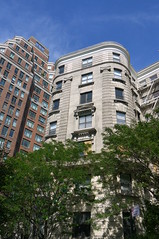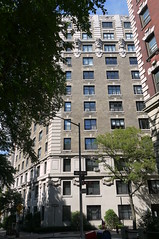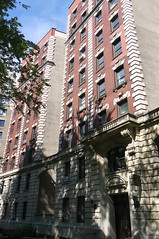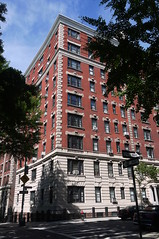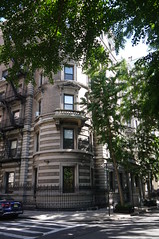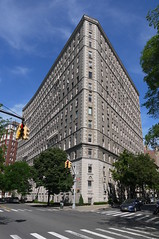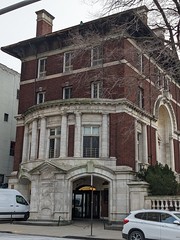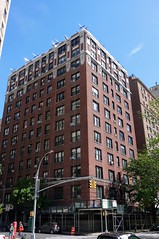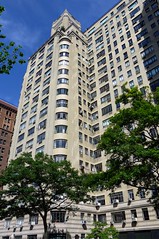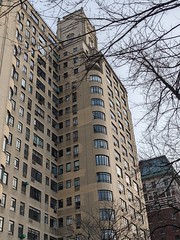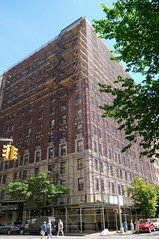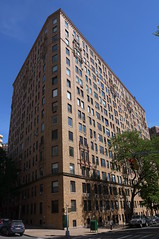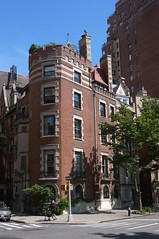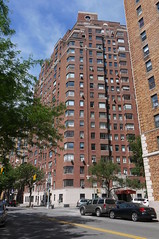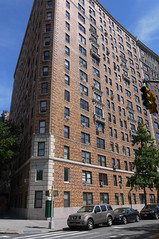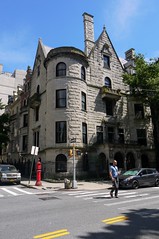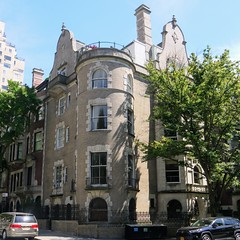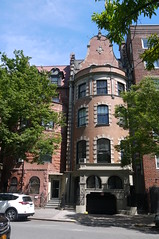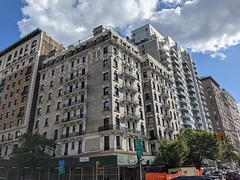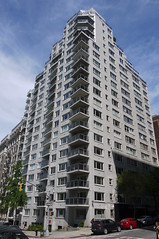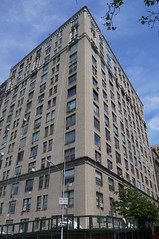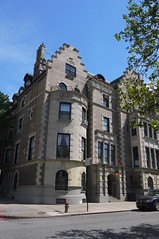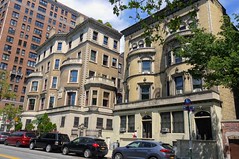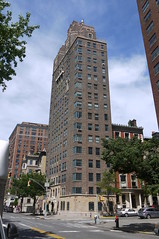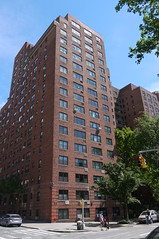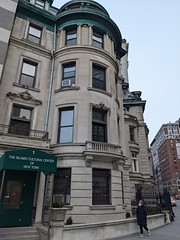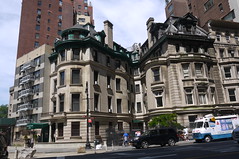West:
Claremont Playground
 Named for the
Claremont Inn, which used to stand on this site. The land overlooking the Hudson from roughly 107th Street to 127th Street, bounded on the east by what is now Broadway, was owned by Dutch farmer (and slaveowner) Adrian Hooglandt, who was the sixth-great-grandfather of Gloria Vanderbilt. During the Revolutionary War, on September 16, 1776, the Battle of Harlem Heights was fought here. Afterwards, in 1784, the land was sold to Nicholas de Peyster, who in 1796 sold the northern end of the estate, from 121st Street on up, to linen merchant George Pollock, who built a summer home called Monte Alta here on what was then called Strawberry Hill. Pollock only lived here three years—during which time his young son St. Claire died in a fall here.
Named for the
Claremont Inn, which used to stand on this site. The land overlooking the Hudson from roughly 107th Street to 127th Street, bounded on the east by what is now Broadway, was owned by Dutch farmer (and slaveowner) Adrian Hooglandt, who was the sixth-great-grandfather of Gloria Vanderbilt. During the Revolutionary War, on September 16, 1776, the Battle of Harlem Heights was fought here. Afterwards, in 1784, the land was sold to Nicholas de Peyster, who in 1796 sold the northern end of the estate, from 121st Street on up, to linen merchant George Pollock, who built a summer home called Monte Alta here on what was then called Strawberry Hill. Pollock only lived here three years—during which time his young son St. Claire died in a fall here.
By 1806, the land was owned by Michael Hogan, one of the "great merchants of his day," who built a new mansion called Claremont here, perhaps named after his native County Clare (though Hogan was also friends with the Duke of Clarence, who went on to become King William IV of England). Hogan was said to live here with an "Indian princess," and their home was "the scene of some of the most brilliant social festivities in the city."
In 1809, Hogan leased the house to
William "Kitty" Courtenay, a British aristocrat who fled to New York to escape reports of his homosexuality. The next tenat was Theodosia Burr Alston, the brilliant and beautiful daughter of Aaron Burr, and her husband John Alston, governor of South Carolina. (When they married in 1801, the couple inaugurated the tradition of honeymooning at Niagara Falls.) Theodosia was
lost at sea at the beginning of 1813, trying to return here from South Carolina. The house was leased in 1815-16 to Joseph Bonaparte, brother of Napoleon and former king of Spain, who may (or may not) have entertained Lafayette, Louis Phillipe and Talleyrand while living here.
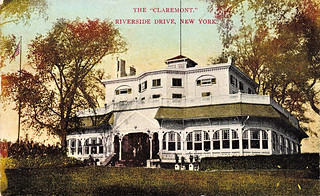
The mansion was converted to the Claremont Inn around 1842, and continued as a celebrated roadhouse after the city acquired the land for Riverside Park in 1872. It catered to big spenders, famous for its $5 steaks and $40 bottles of wine (perhaps $150 and $1,200 in today's money). It hosted celebrations for presidents McKinley and Taft, as well as Adm. George Dewey. It was fashionable into the Jazz Age, with the likes of Cole Porter, George M. Cohan and Mayor Jimmy Walker partying here.
Prohibition brought an end to the inn's golden age, with the establishment reduced to dispensing milk. "Let's drop off in the Claremont for a couple of shots of milk and a lettuce sandwich," the Sun sarcastically suggested. "I've had a big week and I need a milk or two to clear my old bean." The place was relaunched in 1934 by Mayor LaGuardia and Robert Moses, with more democratic pricing; dinner could be had for $1.50 and a beer for 10 cents—think $32 and two bucks, in 2020s terms. It was only too popular; noise complaints led to a court-ordered curfew that forced the inn to reopen as a cafe in 1941. It closed for good in 1947, and by 1951 it was a ruin that burned to the ground. Moses was suspected of having the fire set to save the $100,000 cost of restoration. The playground here was built by the following year.
Memorial to 'an Amiable Child'
 Down the hill from the playground is one of the few graves on public land in New York City. George Pollock's five-year-old son, St. Claire Pollock, fell to his death from the cliffs overlooking the Hudson River and was buried here, memorialized as "an amiable child." After he sold the land, George asked the new owner to "confer a peculiar and interesting favor upon me" by preserving the grave "always enclosed and sacred." (Photo: Jazz Guy)
Down the hill from the playground is one of the few graves on public land in New York City. George Pollock's five-year-old son, St. Claire Pollock, fell to his death from the cliffs overlooking the Hudson River and was buried here, memorialized as "an amiable child." After he sold the land, George asked the new owner to "confer a peculiar and interesting favor upon me" by preserving the grave "always enclosed and sacred." (Photo: Jazz Guy)
Grant's Tomb

Who's buried in Grant's tomb? Why, Ulysses S. Grant, a great general and an
underrated president—alongside his wife, Julia Dent Grant. Completed in 1897, 12 years after the general's death, it was built to a design by John H. Duncan, who won a contest with his plan based on the Mausoleum of Halicarnassus. (Duncan also designed the arch at Grand Army Plaza.) It was funded by 90,000 people donating $600,000, at the time the largest public fundraising project ever.
Riverside Park
 A 267-acre park—four miles long and an eighth of a mile wide—that stretches along
Manhattan's Hudson River waterfront from 72nd to 155th Street. The initial design for the park, which
originally stopped at 125th Street, was laid out by Frederick Law Olmsted, and more or less
implemented from 1872 until 1910. The park as we know it today is largely based on the
vision of Robert Moses, who built the Henry Hudson Parkway, covered the New York Central
railroad tracks, and used landfill to extend the park into the Hudson.
A 267-acre park—four miles long and an eighth of a mile wide—that stretches along
Manhattan's Hudson River waterfront from 72nd to 155th Street. The initial design for the park, which
originally stopped at 125th Street, was laid out by Frederick Law Olmsted, and more or less
implemented from 1872 until 1910. The park as we know it today is largely based on the
vision of Robert Moses, who built the Henry Hudson Parkway, covered the New York Central
railroad tracks, and used landfill to extend the park into the Hudson.
119th Street Tennis Courts, also known as the Over the Tracks Tennis Courts.
Ten acres of the park between 116th and 124th streets have been set aside for bird habitat, with landscaping reverting to forest and meadow, and invasive species replaced with wild-life friendly natives. The blue grosbeak, summer tanager and hooded warbler are regular visitors.

This fountain at 116th Street commemorates the 25th year of the WHPA, formed in
1884 to promote public health. The memorial was designed by Bruno Zimm, who also did Tompkins Square's Slocum Memorial.
Nicholas de Peyster, who in 1784 bought the land overlooking the Hudson from roughly what is now 107th Street to 127th Street, built his country estate on the ridge here opposite what would become West 114th Street.
Kossuth Memorial
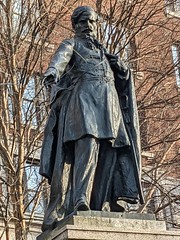 A statue of Hungarian independence advocate
Lajos Kossuth, flanked by figures representing a revolutionary soldier liberating a peasant. He was president of the breakaway Kingdom of Hungary in 1849, and went into exile when it was reabsorbed by the Austrian Empire. His arrival in New York in 1851 sparked
"Kossuth Mania."
A statue of Hungarian independence advocate
Lajos Kossuth, flanked by figures representing a revolutionary soldier liberating a peasant. He was president of the breakaway Kingdom of Hungary in 1849, and went into exile when it was reabsorbed by the Austrian Empire. His arrival in New York in 1851 sparked
"Kossuth Mania."
The sculpture by Janos Horvai was installed in 1928, funded by Hungarian Americans, but had to be reinstalled a couple years later due to corrosion problems.
Samuel Tilden Statue

Tilden was a reform Democrat who was elected governor of New York in 1874 and won the popular vote for president in 1876, but was denied the office via Electoral College shenanigans. He left
$50,000 in his will for a statue of himself, but between heirs contesting the will, disagreement over location and disputes between sponsors and sculptor William Ordway Partridge, the statue was not erected until 1926, 40 years after Tilden's death.
The Andy Kessler Skatepark opened in 1996 as Riverside Skatepark, the first full-sized public skatepark in Manhattan. Its conversion from a disused playground was spearheaded by Andy Kessler, an Upper West Side skateboarder who led the Soul Artists of Zoo York crew. He went on to design and build numerous other skateparks across the city and beyond. After this park was rebuilt and remodeled in 2019, it was renamed for Kessler, who died in 2008 from an allergic reaction to a wasp sting.
Neville Colman Field is named for a
doctor whose malnutrition research led to the fortifying of grain products with folic acid. A white South African who left his country over his opposition to apartheid, Colman was also
the founder of the West Side Soccer League, described as the largest all-volunteer sports organization in NYC.
Peter Jay Sharp Volunteer House
A limestone building from the late 19th
century that was
expanded in 2003 and
turned into a meetingplace for volunteer
groups.
Sharp was the owner of the Carlyle
Hotel and a supporter of music and theater; he
died of melanoma in 1992 at the age
of 61. His foundation funded part of the
reconstruction. (photo: William Avery Hudson)
Franz Sigel Statue

Sigel (1824-1902), a military leader in the failed German revolution of 1848, came to the US as an exile, for a time teaching in New York City public schools. An opponent of slavery, he joined the Union Army at the outbreak of the Civil War, and was soon promoted to brigadier general by Lincoln because of his popularity with German immigrants. He is not remembered as a particularly brilliant general, but he has his defenders.
105th Street Dog Run
Firemen's Memorial

A monument to firefighters who have died in the line of duty—and their horses. It was designed by architect Harold Van Buren Magonigle with sculptor Attilio Piccirilli, who also collaborated on the Maine Memorial in Central Park. The figures flanking the monument, representing Duty and Sacrifice, were both carved using the ubiquitous
Audrey Munson as a model.
John M. Carrere Memorial
A commemorative terrace for architect John Mervin Carrere (1858-1911), designed by his partner Thomas Hastings. The pair,
who met when they worked together at McKim Mead & White, collaborated on the New York Public Library, as well as the Frick mansion, the Manhattan Bridge approach and the Hamilton Fish Recreation Center. Carrere was struck and killed by a car in 1911, and the memorial, which provides access to the interior of the park at 99th Street, was presented as a gift to the city in 1919. It originally cost $9,000; it was restored in 2013 at a cost of $675,000.
Dinosaur Playground
Appears in the 1979 film The Warriors
as the Bronx park where a gathering of the gangs of New York
is interrupted by an assassination. Today the park is home to two fiberglass dinosaurs, a triceratops and a hadrosaur.
|
|
|

560 (corner): A utilitarian building from 1964 with 26 floors and 182 units, owned by Columbia University. Includes the Red Balloon Learning Center preschool.
552: A co-op from 1910.
550 (corner): A six-story building from 1926.
|
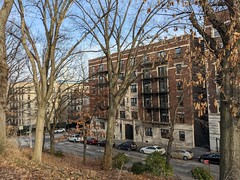
549 (corner): Crescent Court Apart-ments, six stories built in 1925. Like the other buildings on this block, owned by Columbia. Philosopher
Simone Weil lived here from July-November 1942.
548: Six-story Columbia housing from 1926.
547: Six-story Columbia housing from 1926.
530: Six-story Columbia housing from 1926.
528: Six-story Columbia housing from 1926.
527: International House North, an expansion built in 1961.
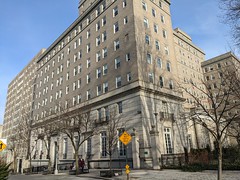
500: Inter-national House was opened in 1924. Funded by John D. Rock-efeller Jr., it was designed to bring together students from all over the world. Residents here have included authors Chinua Achebe and Jerzy Kosinski, musicians Leonard Cohen and Burl Ives, and architect IM Pei, along with various presidents, Nobel Prize winners and CEOs.
Sakura Park
 These two acres, once owned by John D. Rock-efeller, were purchased in 1896 by the city to expand Riverside Park. Originally called Claremont Park, for the avenue that bounds it on the east, it was renamed for the Japanese word for "cherry blossom" after the Committee of Japanese Residents of New York donated trees to be planted here. (Most of the 2,500 trees ordered from Japan were lost at sea, and the survivors arrived three years after the 1909 celebration they were meant to be presented at.)
These two acres, once owned by John D. Rock-efeller, were purchased in 1896 by the city to expand Riverside Park. Originally called Claremont Park, for the avenue that bounds it on the east, it was renamed for the Japanese word for "cherry blossom" after the Committee of Japanese Residents of New York donated trees to be planted here. (Most of the 2,500 trees ordered from Japan were lost at sea, and the survivors arrived three years after the 1909 celebration they were meant to be presented at.)

The park includes a statue of Gen. Daniel Butterfield, composed of "Taps," which faces Grant's Tomb. Rushmore sculptor Gutzon Borglum was reportedly so irritated by demands for revisions to his artwork that he signed his name to the top of the statue's head, claiming that was the one part of the project he hadn't been asked to change.
|
Riverside Church
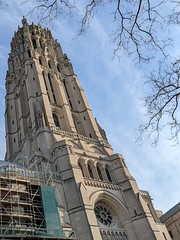
490 (corner): An interdenominational church opened in 1930 with the support of John D. Rockefeller. It features the largest collection of bells in the world.
It has a history of indentifying with progressive causes; Martin Luther King gave his major speech opposing the Vietnam War here on April 4, 1967. Others who have spoken here include Nelson Mandela, Desmond Tutu, Fidel Castro and Cesar Chavez. Jackie Robinson's funeral was held here in 1972, at which Jesse Jackson gave the eulogy.
|
East:

475 (block): Nicknamed the God Box for its blocky architectural form, this building has been called "the closest thing to a Vatican for America's mainline Protestant denominations." Funded by John D. Rockefeller Jr. to encourage interfaith cooperation, the building had its cornerstone laid in 1958 by President Dwight Eisenhower and was completed in 1960. Its limestone cladding was intended to echo that of Riverside Church.
Its tenants have included the National Council of Churches and the national offices of the Evangelical Lutheran Church in America and the Presbyterian Church (USA), all of which have since relocated. Current tenants include the national headquarters of Alcoholics Anonymous, the magazine Commonweal, the Riverside Park Conservancy and the Greater New York Councils of Boy Scouts of America.
|
|
468 (corner): Concord Hall, built 1904, owned by the Interchurch Center.

464: All the buildings between here and No. 445 are owned by Columbia University and were built from 1909-1911.
460: A 12-story building from 1910, owned by Columbia. This was home in 1930 to
William Moulton Marston, creator of Wonder Woman, and his wife and inspiration Elizabeth Holloway, along with Marjorie Wilkes Huntley, who was William and perhaps Elizabeth's lover (and an early Wonder Woman letterer). Poet Rachel Hadas was a child here and wrote a
poem called "460 Riverside Drive."
452: The Mira Mar, from 1910, one of architect
Gaetan Ajello's first major commissions.
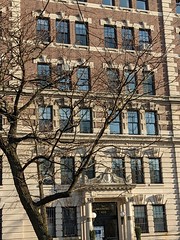
450: The Brookfield. Legendary sportwriter
Grantland Rice lived in this 1909 building, as did New Republic editor
Bruce Bliven, sociologist
Robert Merton (who coined the terms "role model" and "self-fulfilling prophecy"), philosopher
Corliss Lamont and Trump Attorney General
William Barr.
449: Movie producer David O. Selznick (Gone With the Wind, Rebecca) is said to have lived at this no-longer-extent address.
448: Cultural critic Edward Said also lived here.
The Paterno

440 (corner): A majestic apartment building built in 1910 by the Paterno Brothers, a construction family from Naples. The design is by Schwartz & Gross, featuring an unusual curved facade and a grand covered entranceway. The writer Damon Runyon lived here, as did Nation editor
Freda Kirchwey. Giselle takes refuge in an apartment here in the movie Enchanted.
|
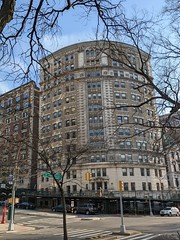
435 (corner): The Colosseum, another building by the Paterno Brothers, with a curve that complements The Paterno. This was home to silent film star
Francis X. Bushman, billed as "the handsomest man in the world," and to Supreme Court Chief Justice
Harlan Stone. Edward Said had an apartment here, as did Joseph Paterno,
one of the brothers who built the place.

434: St. Anthony Hall, clubhouse for the Delta Psi fraternity, which was founded at Columbia in 1847, making this the Alpha Chapter. (It was founded on January 17, the feast of St. Anthony.) This building was completed in 1899.
431 (corner): Woodbridge Hall. This was home to
Rafael Diez de la Cortina y Olaeta, who introduced the use of phonographs to teach foreign languages.
|
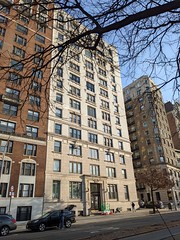
420 (corner): The Hamilton, 13 floors built in 1912 to a Gaetan Aiello design; formerly known as Cliff House. This building has been home to columnist
Franklin P. Adams, writer/chef Anthony Bourdain, art critic Arthur Danto, cartoonist
Rube Goldberg, charter school CEO Eva Moskowitz and theater impresario
Roxy Rothafel.
Previously on this site was the Greek Revival Carrigan Mansion, built in 1836 for Andrew Carrigan, president of the Emigrant Industrial Savings Bank.
|

417 (corner): The Cliff Haven, 13 stories by Denby and Nute from 1918. Its residents have included
Carl Laemmle, founder of Universal Studios, and Clinton press secretary George Stephanopoulos.
414-415: Two
townhouses from 1910 with strikingly bayed facades.
410 (corner): Twelve-story building from 1910. It's been home to Edward Said and anti-war journalist
Jonathan Schell (NNYMUWS).
|

404 (corner): The Strathmore, 12-story Schwartz and Gross building from 1909. Residents have included theologian Reinhold Niebuhr, publisher George Delacorte, actor Isabella Rosselini League of Women Voters co-founder Carrie Catt and DA
Frank Hogan. In The Marvelous Mrs. Maisel, Midge and Joel live in Apt 9C here.
400: Seven stories of handsome red brick designed by George F. Pelham—from 1908.
|
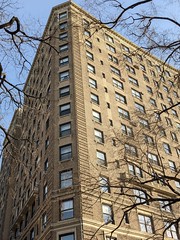
395 (corner): A 16-story building by Gaetan Ajello, finished in 1924. It was home to aviator
Elinor Smith, the only person to have flown under all four East River bridges.
390 (corner): Another Ajello building from 1924. This one was home to singer/songwriter Carole King.
|
|
385: The Marvelous Mrs. Maisel lives at this
imaginary address; her apartment building resembles the real-life No. 380.

380 (block): The Hendrick Hudson, named for the English sea captain who explored the Hudson River on behalf of the Dutch East India Company. Residents have included developer Abraham Lefcourt, cinema mogul Marcus Loew and Joseph Weber of the vaudeville team Weber & Fields. It was the first home of the Gilbreth family, inspiration for the novel and movie Cheaper by the Dozen.
|
W 110TH ST
===> E
Boundary between Morningside Heights and Bloomingdale
|
East:
375 (corner): A 1922 Renaissance Revival apartment building by Gaetan Ajello.

370 (corner): A 15-story building from 1923 by Schwartz & Gross. Philosopher
Hannah Arendt lived here from 1959 until her death in 1975.
Other residents have included
Grace Zia Chu, who popularized Chinese cooking in America; Clarence Lebel, who invented the fluorescent lightbulb; illustrator Norman Price; British Labour politician
John Strachey; and
Robert G. Thompson, chair of the New York State Communist Party.
|
East:
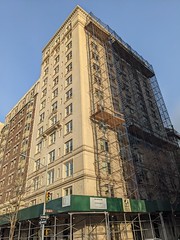
360 (corner): The Rutherford, 13 floors by Gaetan Ajello from 1917. Author William S. Burroughs lived here briefly in 1944-45.
|
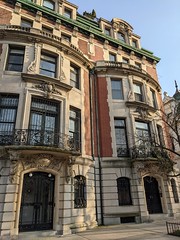
352-353: A Beaux Arts townhouse designed by Robert D. Kohn for silk merchant Adolphe Openhym, completed in 1901. Openhym killed himself in 1903 by jumping off the High Bridge connecting Manhattan and the Bronx.
It was later owned by the Jesuits, who used it as a residence for young priests before selling it in 1977 to
Jim Rogers, investor and financial commentator. Rogers in turn sold it to oil heiress Helen LaKelly Hunt in 2008 for $15.5 million.
The building appears as the home of criminal psychologist Rebecca Neff in the 1981 film Wolfen.
Schinasi Mansion

351 (corner): Built in 1907 for cigarette maker Morris Schinasi, this is the last remaining detached house in Manhattan still in use as a single-family residence. It was designed by William Tuthill, architect of Carnegie Hall, who sued Schinasi for $5,655.65 in unpaid fees. After Schinasi's death in 1928, the building went through several purposes, including the Semple School for Girls; the Children's Mansion, a Columbia University daycare center; and the Experimental College, a Columbia/Barnard residential program. In 2013, it was bought by Goldman Sachs vice chair Mark Schwartz.
The house appears in the TV show White Collar as the home of the elderly widow whom the con artist main character stays with.
|

340 (corner): Artist Jasper Johns and cultural critic Susan Sontag have both lived in this 1925 building—15 floors designed by Sugarman & Berger. (NNYMUWS).
|
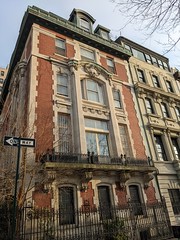
337 (corner): A 1902 red-brick mansion designed by Robert D. Kohn. The first owner was Shakespearean actor Julia Marlowe; other residents have included pencil maker Lothar W. Faber, painter Michael De Santis and actor Sherry Bronfman.
336:
Limestone townhouse by Hoppin & Koen, occupied by the family of Raymond Penfield, second president of Goodyear, from 1905 through 1944. Nina Simone later lived here.
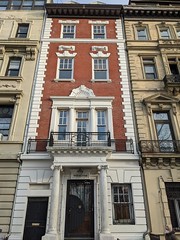
335: Another Hoppin & Koen townhouse from 1902. In the early 1910s, Dr. A.L. Soresi was conducting weird science experiments on dogs here—for example, grafting the leg of a dead dog onto a live dog. The Frankensteinesque doctor was arrested in 1913 as a public nuisance. Soon afterwards, pencil maker Lothar Faber moved here from No. 337 on the corner, living here until his death in 1943. Argentine economist and Columbia professor
Graciela Chichilnisky now owns the building.

334: This was the home of
Jokichi Takamine, a biochemist who was the first to isolate adrenaline; he was followed by toothpaste maker Richard Forhan, whose fire here in 1928 destroyed much of Takamine's art collection.
In 1934, there was a brothel here, run by Madeline Tully, where Bennie "the Bum" McMahon hid out after pulling off an armored car robbery in Brooklyn and then accidentally shooting himself in the leg on the getaway boat. The story's sad end is told in The Man With the Sawed-Off Leg, by Daniel Wakin, which explores the history of this block.
In 1930, this building was briefly home to the
India Centre, intended to promote understanding of the culture of India.
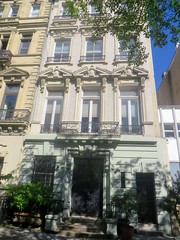
333: This townhouse was built in 1902 along with Nos. 300-332 by builder Joseph A. Farley. After it became an apartment building in 1945, author Saul Bellow lived here, where he wrote The Adventures of Augie March and Seize the Day. Later jazz great Duke Ellington bought the building as a home for his sister, who also ran his music publishing business here; Ellington lived here with his sister from 1961 until his death in 1974.
New York Buddhist Church
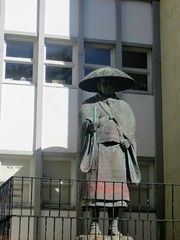
332: The only post-war building on the block, the structure at this address was built in 1955 by the first Buddhist congregation in the city. Hozen Seki founded the church in 1938 before being placed in an internment camp from 1942-45. The bronze statue in front, depicting Buddhist monk
Shinran Shonin, used to stand in Hiroshima and survived the atomic bombing.
The townhouse formerly at this address was bought by publisher William Randolph Heart to house the father of his lover Marion Davies, who lived in a place Hearst gave her next door.

331: This Beaux Arts townhouse was built in 1902 for publisher William Paul Ahnelt, whose Pictorial Review magazine published The Age of Innocence in serial form. Hearst bought the building in 1918 for Marion Davies, a 21-year-old showgirl from the Ziegfeld Follies. He moved her to California in 1925 when rival papers got wind of the extramarital affair. Since 1955, it's been part of the Buddhist church.

330 (corner): A grand limestone townhouse first purchased by baking powder king Robert Benson Davis, whose wife tried to have him declared insane; at one point he had to escape from his own home here by throwing an SOS letter out the window. Now the Riverside Study Center of the right-wing Catholic cult Opus Dei.
|
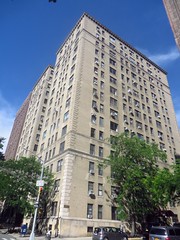
320 (corner): A 1928 building by Leo F. Kunst with 15 floors. Hayley Mills, star of the 1961 Parent Trap, lived here (NNYMUWS).
|

315-318 (corner): This 1920 Art Deco building by Boak & Paris is
19 stories tall.
In 1957, police arrested Vincent "Jimmy Blue Eyes" Alo, an associate of Frank Costello
and a resident here, as part of a police effort to rid the city of "narcotics peddlers,
gamblers, prostitutes, procurers, tinhorns and drifters."
316: Actor Richard Mansfield, who originated the role of the Major General in Pirates of Penzance, had a townhouse at this address. The house seems to have subsequently been the childhood home of actor Alice Brady, who starred in the first production of Mourning Becomes Electra.
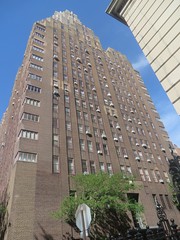
310 (corner): The tallest building on Riverside Drive at 29 floors, the Master Apartments were built by financier Louis Horch for his spiritual gurus, Nicholas and Helena Roerich. The Russian-born Theosophists were founders of the Master Institute of United Arts; Nicholas co-wrote the scenario for Stravinsky's Rites of Spring and is rumored to have suggested to his admirer Henry Wallace that a pyramid be placed on the back of the dollar bill.
The building, opened in 1929, was designed (by architect Harvey Wiley Corbett) to house the Roerichs and their followers, along with a museum for Nicholas' paintings and an art school. Horch and the Roerichs had a falling-out in the mid-1930s, resulting in the couple's eviction and the Roerich Museum becoming the Riverside Museum. The building retained an intellectual and artistic atmosphere; among the tenants were psychoanalyst Otto Rank, choreographer Tommy Tune, jazz composer Billy Strayhorn and author Elie Wiesel (NNY).
|

300 (corner): A 1924 building by George F. Pelham with 14 floors. Replaced the mansion of glovemaker William Foster, which was torn down in 1922.
|
|
299 (corner): Twelve stories from 1911, designed by Evan T. Macdonald.
294: This
Beaux Arts townhouse from 1901 was designed by Schickel & Ditmars for William Baumgarten, a high-end interior decorator known for his reproduction tapestries. It was later home of
Nikolai Avksentiev, who was president of the Russian Republic for a few weeks in 1918; he died here in 1943.

292-293: These 1897 townhouses by CPH Gilbert have striking rounded bay windows.

290 (corner): A 15-story building from 1924. Opera star Geraldine Farrar lived here.
|
|
285: Designed by Rosario Candela for Charles Paterno, this 15-story building was completed in 1926. This was the home of Anton Fokker, airplane maker.
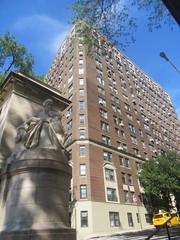
280 (corner): Oxford Tower, a 1926 apartment building also designed by Candela and built by Charles Paterno. Said to be the first building where each apartment came with a refrigerator—cooled by burning gas in those days, oddly enough.
Elaine Barry, John Barrymore's fourth wife, lived here when she was a teenager and dating the actor (NNY).
|
East:

276 (corner): The Wendolyn, designed in 1910 by WK Rouse and LA Goldstone. It replaced the
Furniss Mansion, a stately white-pillared house built c. 1800 on land formerly belonging to royalist Charles Ward Apthorp. A hundred years later it was a sort of artists colony; Gertrude Stein was probably the most famous resident.

270 (corner): Glen Cairn, another 1910 apartment building by Rouse & Gladstone. Mary Pickford moved here with her family when the building was new and she was an 18-year-old silent movie star.
Madonna stayed here for two weeks in 1978 when she first moved to NYC from Detroit. The mystery/comedy Only Murders in the Building, set in an Ansonia-like building on the Upper West Side, shot most of its interiors here.
269: Opera star Rosa Ponselle lived at this former address (NNYMUWS).
|
East:

265 (corner): A 1910 building by George F. Pelham. The penthouse reportedly appears in Woody Allen's Manhattan (1979).

260 (corner): The Chesterfield, a 1910 building by Rouse & Gladstone.
|
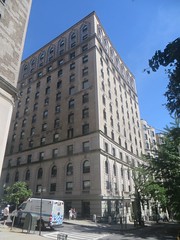
258 (corner): The Peter Stuyvesant, a 1912 building designed by William Rouse. Carter Horsley praises its "fabulous arched windows on the top floor...outlined in deep, vibrant blue glazed terracotta." John Purroy Mitchell, mayor from 1914-17, lived here, as did inventor
Charles E. Scribner (NNYMUWS). More recently, it's been home to Nobel-winning economist and Columbia prof
Joseph Stiglitz.
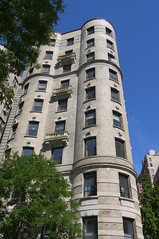
250 (corner): The Victoria, nine floors from 1903, designed by George F. Pelham with a cylindrical corner. Here lived
Harriot Stanton Blatch, daughter of Elizabeth Cady Stanton; Blatch founded the Equality League of Self-Supporting Women and organized the city's first big suffrage parade in 1910.
|
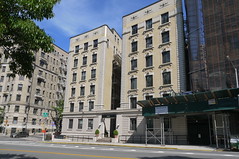
244 (corner): Six stories from 1900.
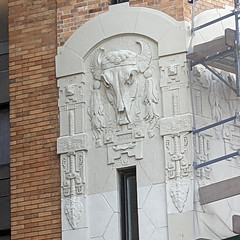
243 (corner):
Cliff Dwelling apart-ments (1916), an asym-metrical building designed by Herman Lee Meader with a frieze featuring Mayan-inspired bison skulls, cougars and rattlesnakes.
Uwe Johnson, German author, lived here with his family from 1966 until 1968; his novel Anniversaries is set here.
|
|



































































